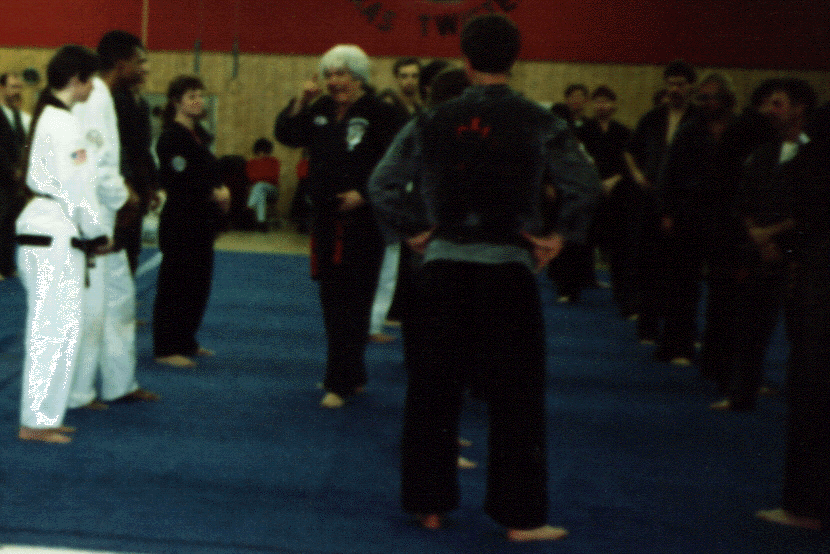   | ||
       |
||
   | ||
       |
||
What is American Kenpo?
The American Kenpo system is an all inclusive, highly
practical martial art developed by Senior Grandmaster Edmund
Parker. It offers far more in content, technical
understanding, mental awareness, and street survival than
other systems of the martial arts.
How was American Kenpo developed?
Edmund Parker, the founder of American Kenpo, began his
study of the martial arts as a teenager in Honolulu, Hawaii.
Growing up in a rough section of town, he was already aware
of the need for effective self defense. He would always
evaluate what he was learning in martial arts class within
the context of his street fighting experience. He found
that his training did indeed contain many practical
techniques that would be effective in a street confrontation
as well as some that he knew simply would not work in real
self defense. Many techniques were outdated and designed
for situations that did not occur in the American lifestyle.
Eventually Mr. Parker set about the task of developing a
system of martial arts that would teach a person how to
defend themselves in today's environment.

Why is American Kenpo described as "all inclusive"?
The system addresses all types of attacks:
Training also includes mental and physical preparedness and a strong emphasis on the underlying principles and concepts of combat as well as technical understanding of the movements involved.
Why do I need to know all this if I just want to learn self
defense?
The principles and concepts allow you to evaluate the
techniques you learn in a variety of situations. This
enables you to become "self correcting." If a movement
violates one of the principles you have learned, you know it
will not be as effective. Knowing "how" to perform a
movement is good but knowing "why" you perform it allows you
to maximize the effectiveness of your actions in any given
situation.
What is the history of Kenpo?
Kenpo traces its roots to the Chinese martial arts. Mr. Parker's
instructor was a Chinese man named William K. S. Chow. He learned from his
father a Shaolin based martial art that had been passed down generation to
generation through his family. Mr. Chow also added to his martial arts
knowledge by cross training with a Japanese man named James Mitose. He also
had learned a family art called Koshoryu Kempo. So the art Mr. Parker
learned was primarily Chinese with some Japanese influences. (For a more
detailed history of Kenpo refer to "Infinite Insights into Kenpo, Vol. 1" by
Ed Parker Sr.)
What is the difference between the Chinese and Japanese aspects?
Mr. Chow's Shaolin based family art was very circular in its movements.
Circular movements are referred to in the martial arts as "soft" style moves.
The Koshoryu Kempo moves were "hard" or linear in nature. Mr. Parker
credited Mr. Chow with the effective combining of linear and circular
movements.
What type of movements does American Kenpo use?
American Kenpo, as a fighting art, is characterized by the use of close
range weapons delivered with speed and power. As well as striking with the
hands and feet, the use of knees, elbows, forearms, leg checks and buckles,
and take downs are commonly employed. The effective blend of straight line
movements of Japanese karate and circular techniques of Chinese kung fu, used
with a multiple strike response to an attack, comprises much of the system.
Multiple strikes are used not so much to annihilate an opponent as to
give the defender an opportunity to cover a mistake or if a target is not
available to go on to another strike without interrupting the flow of the
response.
"When circular moves end, linear begin; when linear moves end,
circular reoccur."
from "The Zen of Kenpo" by Ed Parker
Kenpo's philosophy is non-violent in nature and only the amount of force necessary to stop an attack would actually be used.
"Whatever the attitude, so the response."
from "The Zen of Kenpo" by Ed Parker
Where is Mr. Parker today?
Unfortunately Mr. Parker died from a heart attack on Dec. 15, 1990. But
the system he developed - American Kenpo - is still alive and well. Mr.
Parker left us a large body of knowledge, the product of his 40 plus years of
martial arts training and innovating. Perhaps the most significant thing Ed
Parker did to preserve what he spent his life creating was to base the
American Kenpo system on logical and scientific principles and concepts. He
observed while living how many martial arts became watered down as more
knowledge was lost with each successive generation of students. He conversely
noted how the sciences such as medicine, chemistry, aeronautics, etc.,
continued to add to the existing body of knowledge with each successive
generation. This is why the American Kenpo system is based on principles and
concepts...so each generation of students can benefit from their predecessors
as well as add contributions of their own for future students to experience
and learn from.

 can build a site for you too.
can build a site for you too.
Contact us about your design needs.